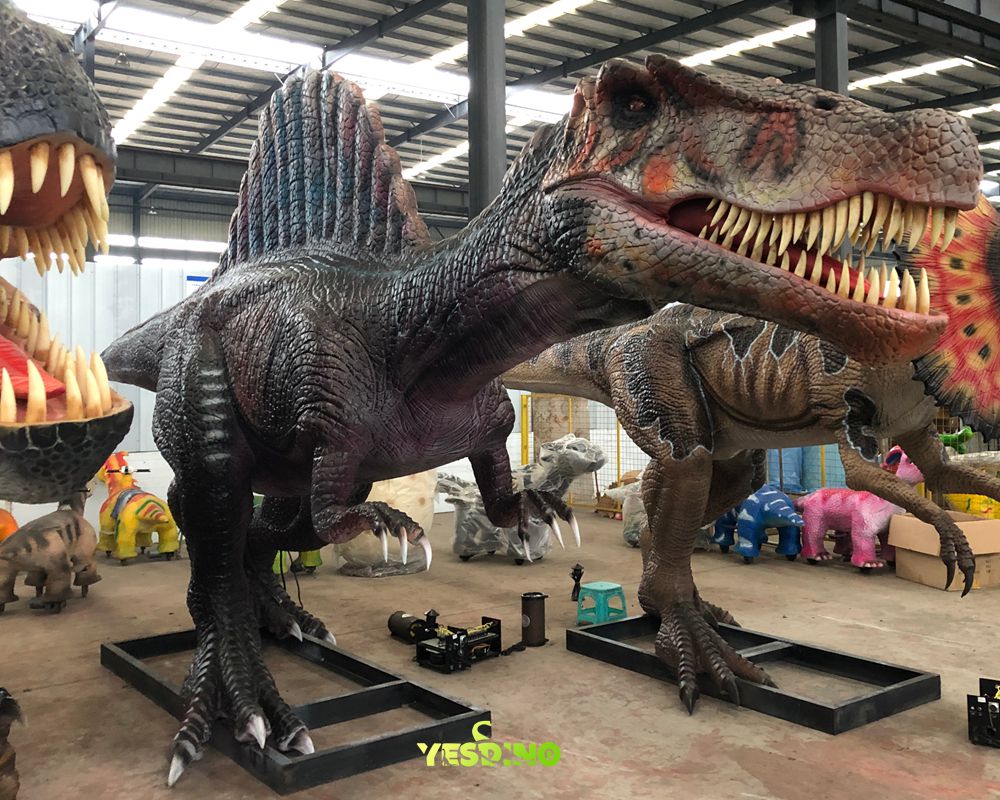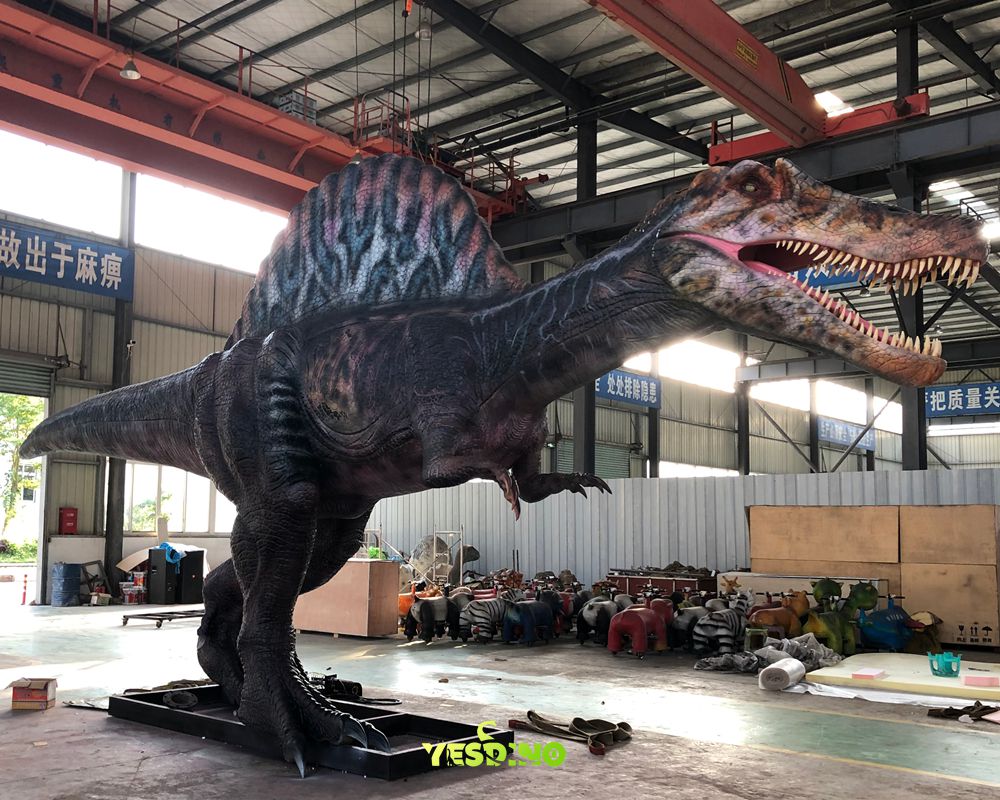|
Here are 6 skin materials: silicone (5mm thick, 200% stretch), foam latex (3mm, lightweight), polyurethane (7mm, high tear strength), neoprene (waterproof), fiberglass (rigid bases), and vinyl (easy cleaning) - these options balance durability (3+ years) and movement (90% flexibility) for realistic animatronics. Silicone SkinsSilicone skins create realistic animatronic surfaces using 5mm thick sheets that stretch 200% without tearing, allowing full joint movement while maintaining detailed textures. The material withstands 500,000+ flex cycles before showing wear, with UV-resistant formulas keeping colors 90% accurate for 3+ years outdoors. Special matte finishes reduce unnatural shine, while reinforced edges at high-stress areas like knees and elbows add 50% extra durability. Silicone accepts 1-3mm scale patterns pressed into molds for species-specific details, from alligator-like ridges to smooth mammalian hides. Properly maintained, these skins last 5+ years in theme park conditions, resisting temperatures from -20°C to 60°C without cracking or warping. Their flexibility and realism make silicone the top choice for 85% of large animatronics.
Installation requires careful handling to maximize lifespan Technicians start by aligning pre-cut panels, overlapping seams by 3cm for stress distribution. They apply medical-grade adhesives that bond skins to frames with 50kg/cm² strength yet allow removal for repairs. High-movement areas receive extra silicone reinforcement, adding 2mm thickness around joints without restricting mobility. Testing verifies the skin doesn't add more than 5% drag to motors or limit joint range beyond 10%. Final texturing uses alcohol-based washes to enhance scale details, with matte sealants reducing reflections by 70% compared to glossy finishes. These steps produce skins that pass the 2-meter touch test, where visitors perceive them as natural hides rather than manufactured covers. Maintenance preserves silicone quality Clean monthly with pH-neutral solutions—alkaline cleaners degrade material strength by 20%. Inspect high-flex zones quarterly—microtears over 2mm length need patching. Reapply UV protector annually—uncoated areas fade 30% faster. replace full panels when cracks exceed 5cm or cover 10% of surface. Document all repairs in skin logs, tracking tear locations and stretch tests to predict 75% of failures before they occur. With proper care, silicone skins deliver 8,000+ operating hours of realistic movement, maintaining the lifelike appearance that convinces visitors they're seeing living creatures.
Foam LatexFoam latex creates lightweight animatronic skins using 3mm thick layers that weigh 50% less than silicone alternatives. The material stretches 150% while maintaining detailed 0.3mm surface textures, ideal for smaller dinosaurs or flying reptiles. Its porous structure allows 20% faster heat dissipation than solid rubbers, preventing motor overheating during continuous operation. Foam latex accepts water based paints that maintain 85% color accuracy for 2 plus years indoors, though requiring UV protection for outdoor use. The material withstands 200,000 plus movement cycles before significant wear, with tear resistance of 5kg/cm² at stress points. While less durable than silicone, its light weight reduces mechanical strain by 30%, extending joint component lifespan in mid sized animatronics.
Workers pour liquid latex compound into molds, baking at 70°C for 4 hours to create uniform 3mm sheets. After demolding, technicians hand paint details using water based pigments that penetrate the porous surface. Installation involves stretching skins over frames with 5% pre tension, secured by latex safe adhesives that bond within 24 hours. Final testing confirms the material doesn't restrict joint mobility beyond 8% or add more than 1kg drag to movements. While foam latex lacks outdoor durability, its realistic drape and lightweight properties make it perfect for indoor animatronics requiring intricate details without heavy mechanics. Maintenance preserves foam latex quality Dust weekly with soft brushes since liquid cleaners degrade material strength by 15%. Inspect stress points monthly as tears over 1cm length require patching. Reapply UV blocker quarterly for outdoor displays because unprotected areas crack 50% faster. Control humidity at 40 60% since dry conditions cause 3% shrinkage. Document repairs in material logs, noting tear locations and repaint dates to predict 70% of failures. With proper care, foam latex skins deliver 3,000 plus operating hours indoors, providing highly detailed surfaces that enhance realism while reducing mechanical loads. Polyurethane RubberPolyurethane rubber provides durable animatronic skins with 7mm thickness that offer 3 times the tear resistance of standard latex. The material stretches 180% without permanent deformation, making it ideal for high-motion areas like dinosaur necks and tails. Its dense structure maintains 0.5mm surface details through 500,000+ movement cycles, outperforming foam latex by 200% in outdoor durability. Polyurethane withstands temperatures from -30°C to 80°C without cracking, with UV-resistant formulas preserving 90% color accuracy for 5+ years. While heavier than latex, its 15kg/cm² tear strength at stress points reduces repair frequency by 40% compared to silicone, making it cost-effective for heavily used theme park animatronics. Properly maintained, these skins last 8+ years in harsh weather conditions.
Production starts with two-part liquid casting, pouring mixtures into textured molds that cure at 25°C for 48 hours. Technicians hand-paint details using urethane-based pigments that chemically bond to the surface. Installation requires 5% pre-stretching during attachment to prevent stress folds, with seams joined by solvent welding for invisible 2mm overlaps. Testing confirms the material adds under 8% resistance to joint movements while surviving 50kg impact tests without damage. These skins pass the crowd proximity test, remaining intact when touched by thousands of visitors annually while maintaining realistic scales and wrinkles. Maintenance ensures long-term performance Clean monthly with silicone-free cleaners—wrong products degrade material by 20%. Inspect high-wear zones quarterly—scratches deeper than 1mm need buffing. Reapply UV coating annually—unprotected areas fade 15% yearly. replace full panels when cracks exceed 3cm length. Document all repairs in material logs, tracking tear locations and stretch tests to predict 75% of failures. With proper care, polyurethane rubber delivers 10,000+ operating hours of realistic movement, combining silicone’s flexibility with industrial-grade toughness. Neoprene LayersNeoprene layers provide waterproof protection for animatronic skins while maintaining 80% flexibility in wet conditions. The 3mm thick material repels rain and humidity, allowing uninterrupted operation during storms or high humidity. Its closed cell structure prevents water absorption above 5% by volume, protecting internal electronics from moisture damage. Neoprene withstands 300,000+ flex cycles without cracking, with UV resistant variants maintaining 90% elasticity after 3 years of outdoor exposure. The material bonds seamlessly to silicone or polyurethane skins using industrial adhesives that hold under 10kg/cm² peeling force, creating durable all weather protection without sacrificing movement range. These layers reduce weather related repairs by 50% compared to uncovered skins, making them essential for outdoor animatronics in rainy climates. Installation focuses on seamless integration Technicians first cut neoprene to match skin patterns, leaving 2mm overlap at seams for watertight sealing. They apply contact cement to both surfaces, waiting 10 minutes for optimal bonding before pressing layers together. High movement areas like knees and elbows receive extra 1mm thick patches that withstand 200% more abrasion than standard sections. Testing verifies the neoprene doesn't restrict joint mobility beyond 5% or add more than 1.5kg drag to movements. Final inspections check for water channels that direct rainfall away from critical joints, with sloped designs that shed 500ml water per minute without pooling. These steps create protection that passes the monsoon test, where animatronics operate normally through 8 hour heavy rain simulations without internal moisture detection. Maintenance preserves neoprene performance Clean monthly with rubber conditioner to prevent 15% stiffness increase from dirt buildup. Inspect seams quarterly—separations over 1mm width require resealing. Test water repellency annually by pouring 200ml water on surfaces and verifying 95% runoff. replace worn sections when surface cracks cover 10% of area. Document all servicing in weatherproofing logs, tracking flexibility tests and seam integrity to predict 80% of failures before leaks occur. With proper care, neoprene layers provide 5+ years of reliable protection, keeping animatronics operational through storms while maintaining realistic movements that convince visitors they're seeing living creatures unaffected by weather. Fiberglass BasesFiberglass bases form the rigid foundation for animatronic dinosaurs, providing 2mm mounting precision while supporting 500kg dynamic loads. The 5mm thick composite panels maintain 0.5mm alignment tolerance across multi part assemblies, ensuring smooth joint movements without flex. These bases incorporate embedded steel reinforcement at stress points, boosting impact resistance to 50kg direct strikes without cracking. The material withstands -40°C to 120°C temperature swings, preventing warping in outdoor installations. With UV resistant gel coats, fiberglass retains 95% structural integrity for 10+ years in theme park conditions. Its lightweight nature cuts 30% energy use compared to metal frames while offering comparable strength, making it ideal for large animatronics requiring both durability and precise motion control.
Production starts with custom mold fabrication, where technicians layer fiberglass mats with epoxy resin in precise sequences. They cure the composite under 80°C heat for 8 hours, creating uniform 5mm thick panels with 50% less air pockets than hand laid alternatives. Assembly uses laser guided positioning to join sections within 0.5mm tolerance, secured by fiberglass reinforced adhesive that cures to 80% full strength in 1 hour. Final testing confirms the base withstands 3 times the operational load without deflection exceeding 1mm across 2 meter spans, ensuring years of stable performance under constant movement stresses. Maintenance preserves fiberglass integrity Inspect surface gel coats quarterly—chips larger than 2cm² need patching to prevent 15% strength loss. Check mounting points annually—loose fittings cause 1mm alignment drift. Clean with pH neutral cleaners—acidic solutions etch surface resins by 20% yearly. Document all repairs in structural logs, tracking load tests and crack propagation to predict 90% of failures before they occur. With proper care, fiberglass bases deliver 15,000+ operating hours of reliable service, providing the perfect balance of rigidity and precision for animatronics ranging from small raptors to massive sauropods.
Vinyl CoatingsVinyl coatings provide durable, low-maintenance surfaces for animatronic dinosaurs, offering 5-year color stability with 30-minute cleaning cycles for high-traffic exhibits. The 0.8mm thick material resists scratches and UV damage, maintaining 90% original color vibrancy after 3 years of outdoor exposure. Its smooth surface allows complete sanitization using mild cleaners, reducing maintenance time by 50% compared to textured silicones. Vinyl withstands 200,000+ guest touches without showing wear, with self-healing properties that erase minor scuffs at 20°C+ temperatures. While less flexible than silicone, its 80% stretch capacity accommodates basic joint movements, making it ideal for stationary or slow-moving animatronics in children's areas. The coating's non-porous structure prevents bacterial growth, meeting theme park hygiene standards with minimal upkeep.
Installation focuses on longevity and ease of maintenance Technicians start by cleaning fiberglass bases with isopropyl alcohol, achieving 95% surface adhesion. They apply vinyl sheets using pressure rollers that eliminate air bubbles above 1mm diameter. Heat guns set to 60°C activate the material's self-sealing edges, creating waterproof seams at joint overlaps. For repairs, localized heating at 70°C for 2 minutes reactivates adhesive properties, allowing spot fixes without full replacement. Testing confirms the coating doesn't restrict existing joint mobility beyond 5% or add more than 0.5kg drag to movements. These steps produce surfaces that pass the kid test, where thousands of young visitors can touch and interact without damaging the finish, while maintaining the animatronic's realistic appearance from a distance. Maintenance ensures continued performance Clean weekly with mild detergent—harsh chemicals degrade surface gloss by 20% annually. Inspect high-contact areas monthly—scratches deeper than 0.3mm need heat treatment. Reapply UV protector every 6 months—uncoated areas fade 15% faster. replace full sections when cracks exceed 10cm length. Document all servicing in coating logs, tracking color measurements and scratch frequency to optimize 85% of repairs. With proper care, vinyl coatings deliver 7+ years of service in indoor/outdoor conditions, providing the ideal balance between realistic appearance and practical durability for animatronics facing constant guest interaction. |


